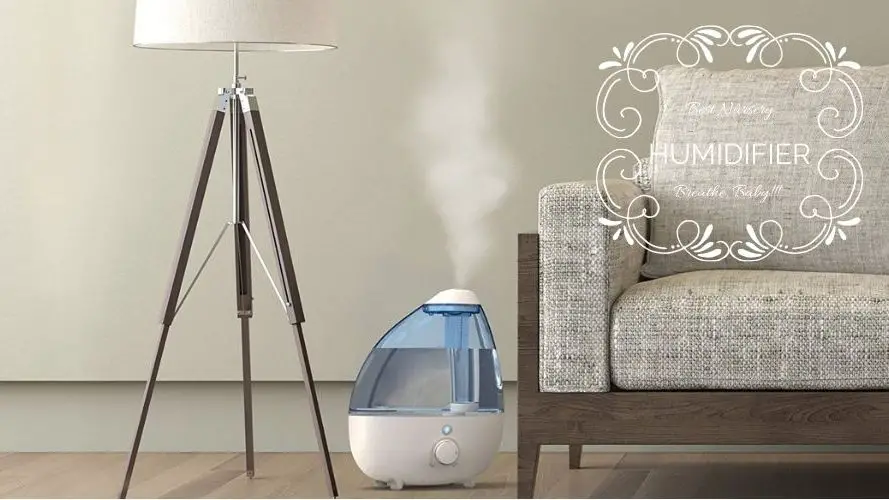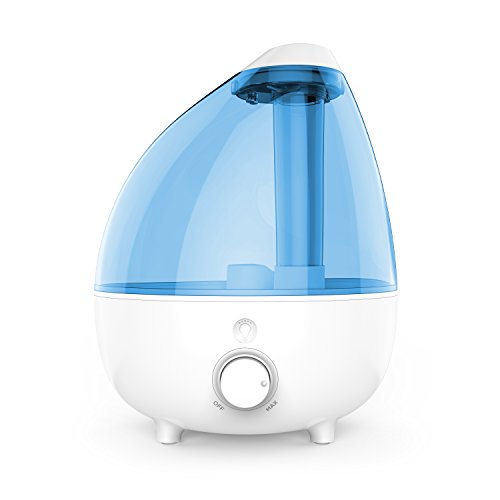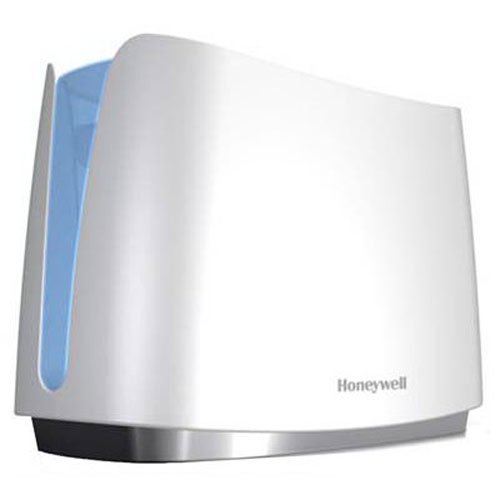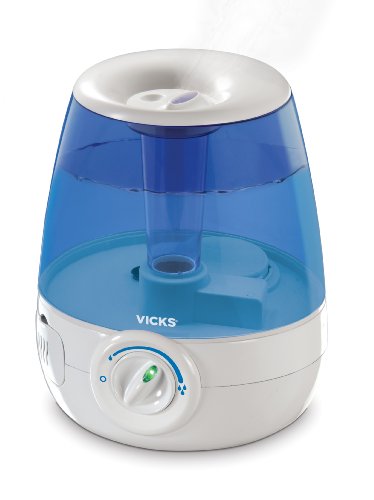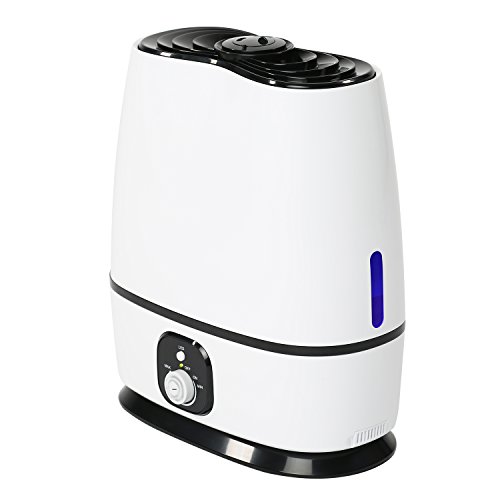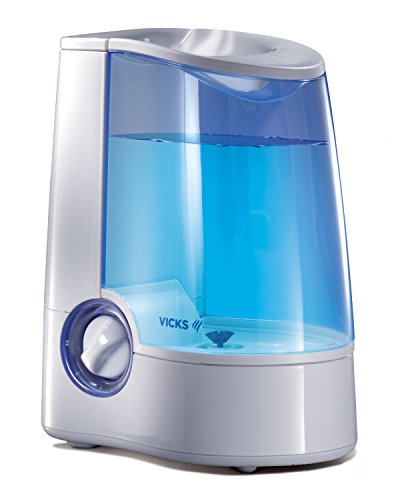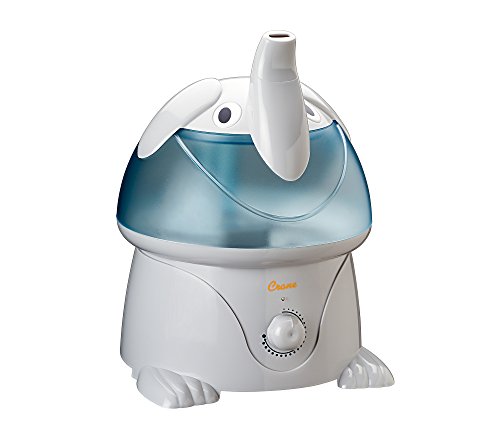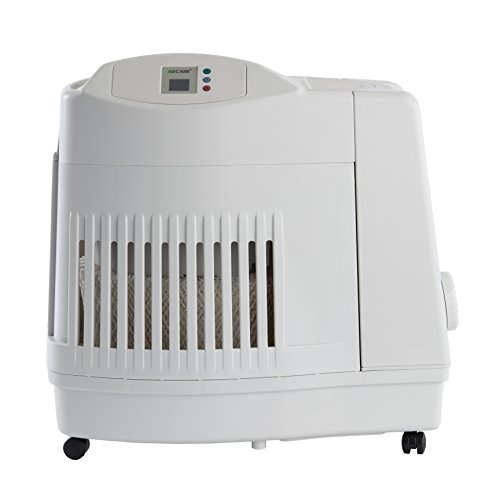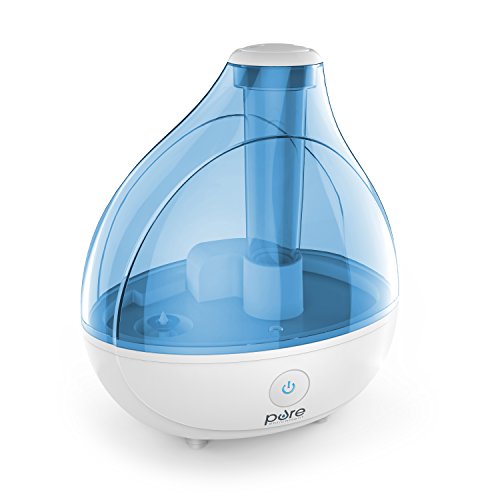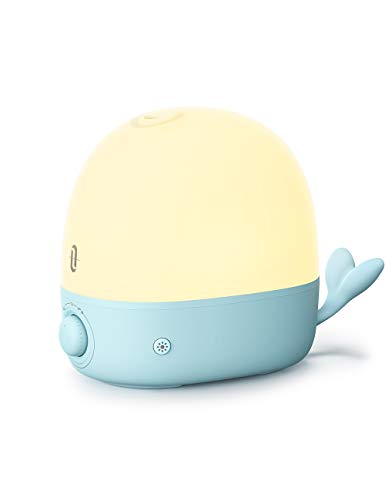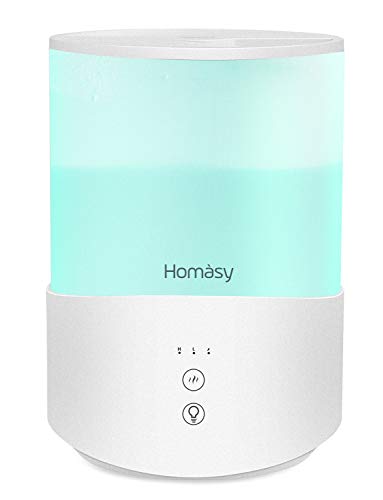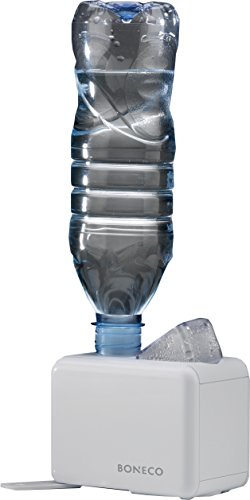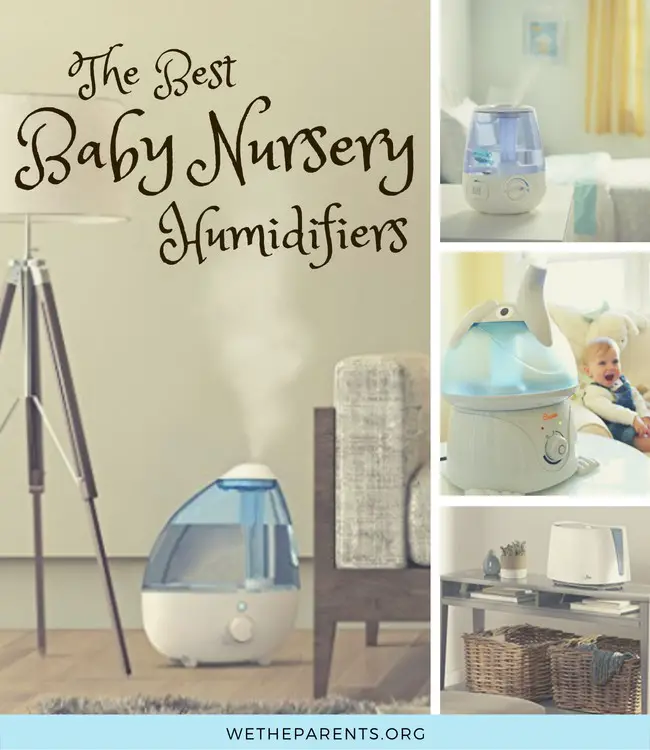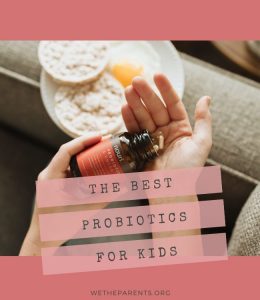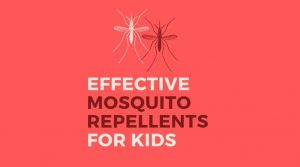Does your baby suffer from congestion, cold, or flu? How about dry and itchy skin, throat, or eyes?
Pediatricians widely agree that humidifiers can help prevent the spread of germs and soothe these common symptoms which are made worse by dry air.1te Pas, A. B., Lopriore, E., Dito, I., Morley, C. J., & Walther, F. J. (2010). Humidified and heated air during stabilization at birth improves temperature in preterm infants. Pediatrics, 125(6), e1427-e1432.
pediatrics.aappublications.org
But which type of humidifier should you buy? And are they safe to keep in your baby’s nursery?
In this guide, we hope to show you some of the best humidifiers for your family’s needs. We’ll then give you some simple tips for keeping your humidifier clean and safe and avoid the genuine risks associated with poor water tank maintenance.
What is a humidifier?
A humidifier is simply a device that adds moisture to the air. This is particularly important in dry or cold climates, or when you are looking to ease the symptoms of congestion and common colds.
A humidifier stores water which it then converts into a fine mist or steam. This is then pumped into your room until it reaches an optimum moisture level.
Different humidifiers achieve this goal in different ways. We’ll take a look at this in a moment, but first…
What are the benefits of a humidifier?
Adding moisture back into your home’s dry air has many advantages. It can:
- Prevent or slow the spread of germs. Likely moist air can limit or even eliminate viruses and bacteria which thrive and move around more easily in dry air. Sure, that’s not to say that adding a humidifier to your home means that no one will ever get sick again, but it does swing the odds in your family’s favor when it comes to avoiding the latest flu outbreak
- Treat cold, flu, and allergy symptoms. Soothes dryness, irritation, or itchiness in the nose, sinuses, throat, and eyes. [Source]
- Soothe dry skin and cracked lips. Humid air can help to relieve dry and itchy patches of skin;
- Help with congestion. Humid air keeps mucus flowing rather than blocking up;
- Improve breathing for asthmatics. Always consult your doctor first, but using a humidifier may improve breathing in children with asthma.2The Benefits of an Air Humidifier 3healthfully.com/the-benefits-of-an-air-humidifier-5690165.html
- Improve sleep. Due to low-level white-noise emitted by unit
- Prevent nosebleeds. Helps to keep mucous membranes moist
- Preserve home furnishings. Optimum air moisture protects the integrity of wallpaper and wooden furniture, eg, cribs and baby gates.
Too much moisture in the air can contribute to sickness by causing dampness on walls, floors, and other nooks and crannies. This allows harmful bacteria and mold to grow. The same is true if you don’t properly clean and maintain even the best humidifiers – nasties can grow and be emitted into the air.
The takeaway… keep your humidifier clean and don’t overdo it.
Editor’s Note:
Many humidifiers recommend sterile water, and regular cleaning. A moist environment can lead to mold, to prevent adding mold to your child’s environment follow the manufacturer’s directions.
Related: Are Humidifiers Good for Babies?

What is the best humidifier for baby?
All humidifiers generally do the same thing, ie, emit water vapor into the air. However, they achieve this in different ways. Some are very baby-friendly, others less so.
Let’s take a look at the pros and cons of each.
Cool mist vs Warm mist
Cool mist humidifiers are (nearly always) best for babies.
Babies and children are curious creatures and having any hot water in an area they can get to is not safe. This is why most pediatricians recommend that you avoid vaporizers or “warm mist humidifiers”.
Additionally, warm mist humidifiers have to heat up the water, so they use more electricity.
The only time you may wish to consider a vaporizer is if (1) you have a child that is prone to getting ill and so “germ-free” is your top priority; (2) you can absolutely guarantee that your child won’t be able to reach the humidifier; and (3) you live in a cool region and want to warm the room a little. (To be perfectly honest, though, an evaporative humidifier ticks all the germ-free boxes without the burn risk.)
Evaporative vs Ultrasonic
There are two main types of cool mist humidifiers: evaporative and ultrasonic. Both can be good for babies but each type has pros and cons. Which is best, depends on your family situation.
Our quick recommendation is this:
Organized and good at daily routine? Then go for an ultrasonic humidifier.
If you are confident that you can create and sustain a daily maintenance ritual, then an ultrasonic humidifier may be your best choice. They do require more frequent cleaning and maintenance but are quieter, use less energy, and look great. (Note: if you live in a hard water area, then you may need to use distilled water which is an added hassle.)
Sound right for you? We recommend the MistAire XL ultrasonic humidifier (link goes to Amazon).
Want less hassle and don’t mind extra ‘lifetime’ cost? Then go for an evaporative humidifier.
Evaporative humidifiers do not require daily maintenance. They will stay germ-free with less frequent cleaning (though you will still need to clean now and again, plus you’ll need to change the filter every few months). If you don’t mind the extra cost of filters but fancy the idea of less cleaning, then an evaporative humidifier is the way to go.
Sound right for you? We recommend the Honeywell “Germ-Free” evaporative humidifier (link goes to Amazon).
Editor’s note: With a new baby or children the last thing a parent wants is more cleaning. Paying a little extra for efficiency and less work is worth it.
Different types of humidifier
So that you can make an informed decision, let’s look at the main three humidifier types more closely.
Ultrasonic humidifier (cool mist)
These humidifiers create a fine mist by exciting and evaporating water using a small diaphragm that vibrates at ultrasonic frequencies.

PROS
Filterless – Ultrasonic humidifiers do not have a filter which saves you the hassle of remembering and ordering new ones.
Cheaper ‘lifetime’ cost – Having no filters to replace (which can be costly), ultrasonic humidifiers.
Quietest – If you want a near-silent humidifier, then this is the one for you.
Beautiful design – Ultrasonic humidifiers tend to come in beautiful designs whereas evaporative ones are boxier.
Compact – Due to the mechanism they use, ultrasonic humidifiers tend to be more compact and therefore can fit into smaller spaces.
Energy-efficient – Ultrasonic humidifiers use the least energy (some use less than a standard light bulb).
CONS
White dust – Dissolved minerals in hard water are picked up and emitted in the mist. These then settle as a fine white dust around the humidifier. The dust is harmless but can be a nuisance to clean. There are solutions to this issue: (1) Some ultrasonic humidifiers contain demineralization filters which prevent the problem but do require replacing over time; (2) Many parents choose to fill their ultrasonic humidifier with distilled water. Again this solves the problem but is an added hassle.
Require frequent cleaning to avoid germs – Because they do not have a filter and don’t use boiling water, ultrasonic humidifiers lack some of the germ-busting abilities of evaporative and vaporizing humidifiers. To make up for this and to keep your ultrasonic humidifier safely germ-free you’ll need to clean and maintain it more frequently than the others.
Evaporative humidifier (cool mist)
Sometimes called “wick humidifiers” these include a large wick or “wet wick filter” which draws up water from the reservoir. The large surface area encourages evaporation as air is forced through it by the fan. The moist air is then blown into the room.

PROS
No white dust – Evaporative humidifiers use a more “natural” method of creating water vapor which doesn’t pick up minerals. This means no issue with white mineral dust.
“Germ-free” – In lab tests, evaporative humidifiers come out on top. [Source]. Their method of evaporation and their filter means that they tend to emit fewer pathogens into the air.
Less daily hassle – It is still important to clean and maintain evaporative humidifiers to avoid stagnant water and mold; however, this can be done weekly rather than daily.
CONS
Expensive filter replacements – The main drawback is the ongoing cost of filters which range from about $7-15 each. Parents have reported having to change them anywhere from 2-weeks to 6-months, though the average seems to be every 2-3 months.
Bulky & Uglier – Evaporative humidifiers are generally large, boxy, and not overly pretty. (At least, that’s our subjective opinion!)
Noisier – Due to the fan mechanism, evaporative humidifiers are noisier than other types. That said, it is generally no more than a gentle hum, and many parents actually see this as a good thing because it helps their babies to sleep.
Vaporizers (warm mist)
Also known as a “steam humidifier” or “warm mist humidifier”, this type of humidifier heats or boils water to create steam which is then pumped into the room.

PROS
Kills germs – Boiling water kills most bacteria. Vaporizers can kill up to 95% of germs.
CONS
Burn risk – The heating element and boiling water create a safety hazard, especially with young children around.
Fire anxiety – Quality vaporizers are generally pretty safe, but having an electrical heating device in your home can be a source of anxiety for parents, ie, worrying about fires. (Or maybe this is just me!?)
Now that you have gotten the basics down, let’s move on to our top pick humidifiers.
Our picks of the best baby nursery humidifiers
Best ultrasonic humidifier
Our opinion
Type: Ultrasonic, cool mist
Filter: No
Room size: Large (500 sq feet)
Duration: Up to 24 hours
Auto shut-off: Yes
Diffuser (essential oils): No
Adjustable mist: Yes
The MistAire XL (check price on Amazon) is our top choice humidifier and all-rounder. Check out its impressive Amazon customer ratings and reviews if you need convincing. The MistAire XL is a beautiful, well-built ultrasonic humidifier that is capable of delivering a huge amount of mist very, very quietly (so there is no need to worry about it waking up the kiddies).
Being the ‘XL’ version, this humidifier comfortably fills large rooms. At the same time, the mist output can easily be adjusted to work in smaller baby nurseries. It also comes with a nightlight on which you can adjust the brightness, and will automatically shut off when the tank is empty.
White noise can enhance soothing a fussy baby. Möller, E. L., de Vente, W., & Rodenburg, R. (2019). Infant crying and the calming response: Parental versus mechanical soothing using swaddling, sound, and movement. PloS one, 14(4), PloS one, 14(4), e0214548.
journals.plos.org
Young infants typically respond well to white noise, a study by the University of London found infants fell asleep faster with use of white noise than without.Spencer, J. A., Moran, D. J., Lee, A., & Talbert, D. (1990). White noise and sleep induction.Archives of disease in childhood, 65(1), 135-137.
researchgate.net
What we love
- Doesn't need frequent refills
- Has self-storing cleaning brush
- Runs very quietly
Watch for
- Setting too high can create condensation on floors and walls
- Shape is a bit unusual
Best for babies with allergies
Our opinion
Type: Evaporative, cool mist
Filter: Yes
Room size: Medium (360 sq feet)
Duration: Up to 24 hours
Auto shut-off: No
Diffuser (essential oils): No
Adjustable mist: Yes
The Honeywell HCM350W (check price on Amazon) is a fantastic humidifier, and certainly our top choice evaporative humidifier.
Its biggest strength is its ability to prevent germs. Firstly, there is a UV light which kills waterborne bacteria as they enter the tank. Next, the “wet wick filter” is antibacterial, preventing pathogens from passing through it. Together this results in the humidifier emitting up to 99.9% germ-free moisture into the into the air.
The Honeywell HCM350W is significantly quieter than most evaporative humidifiers (some can be pretty noisy). That said, it still produces a low-level hum caused by the internal fan. Some parents actually see this as a bonus, ie, it acts like a white-noise machine, soothing their babies to sleep.
What we love
- Requires less frequent cleaning
- No residue
- UV light kills bacteria
Watch for
- Filters are expensive
- Bulky shape
Best for congestion and colds
Our opinion
Type: Ultrasonic, cool mist
Filter: No
Room size: Medium (350 sq feet)
Duration: Up to 24 hours
Auto shut-off: Yes
Diffuser (essential oils): No, but uses Vicks VapoPads which include rosemary and lavender scents
Adjustable mist: Yes
The Vicks V4600 Filter-free (check price on Amazon) is a good ultrasonic humidifier that works well in small to medium-sized baby rooms or nurseries. It has an adjustable moisture dial and an easy to clean tank. Like other Vicks humidifiers, this one includes a small tray where you can pop Vicks VapoPads for added soothing vapors.
What we love
- Runs quietly
- Two scents: menthol and lavender/rosemary
- Large capacity tank opening makes cleaning easy
Watch for
- Scented pads not safe for kids under two
- May leave residue
Best humidifier with essential oil diffuser
Our opinion
Type: Ultrasonic, cool mist
Filter: No
Room size: Large (400 sq feet)
Duration: Up to 50 hours
Auto shut-off: Yes
Diffuser (essential oils): Yes
Adjustable mist: Yes
The Everlasting Comfort (check price on Amazon) has an easy-to-use essential oil tray; however, this is no cheap gimmicky machine like some of the other diffusers on the market. Rather, the Everlast is a combination of a well-designed, large capacity (5L) humidifier and an oil diffuser. It is a sturdy humidifier and won’t topple easily – a bonus if your kids are little tornadoes around the house! It is also easy to grip, handle, and clean.
What we love
- Runs for up to 50 hours
- Fills large rooms easily
- Can be used with favorite essential oils
Watch for
- Filling tank may be time-consuming, complex
Best warm mist humidifier
Our opinion
Type: Vaporizer, warm mist
Filter: No
Room size: Medium (350 sq feet)
Duration: Up to 12 hours
Auto shut-off: Yes
Diffuser (essential oils): No, but uses Vicks VapoPads which include rosemary and lavender scent
Adjustable mist: Yes
The Vicks V745A Warm Mist Humidifier (check price on Amazon) is our top pick warm mist humidifier. It has an inherent safety risk due to its heating element and boiling water, so you’ll need to be completely sure that your little one cannot get to it. However, if this is not an issue, then this humidifier is a good choice if you want both germ-free mist (it kills 95% of bacteria) and Vicks’ soothing menthol vapors or other liquid medicine inhalants.
What we love
- Runs quietly
- Less cleaning and maintenance than ultrasonic humidifiers
- Features "medicine cup" used for Vicks VapoSteam/other liquid inhalants
Watch for
- Make sure to keep out of reach due to risk of burns
Cutest humidifier for baby nursery
Our opinion
Type: Ultrasonic, cool mist
Filter: No
Room size: Small – Medium (250 sq feet)
Duration: Up to 24 hours
Auto shut-off: Yes
Diffuser (essential oils): No
Adjustable mist: Yes
The Crane Elephant (check price on Amazon) is our personal favorite amongst Crane’s adorable animal range. There are many animals and colors so you’ll be sure to find one that matches your baby’s nursery theme. Beyond being cute, they are decent and dependable ultrasonic humidifiers that will raise the humidity (in small rooms) for up to 24 hours, and bring your little one relief from cold and flu symptoms.
What we love
- Energy-efficient
- Good strength for small room
- Cute product design
Watch for
- Not powerful enough for larger rooms
Best whole-house humidifier
Our opinion
Type: Evaporative, cool mist
Filter: Yes
Room size: Large – Whole-house (3600 sq feet)
Duration: Up to 24 hours
Auto shut-off: Yes
Diffuser (essential oils): No
Adjustable mist: Yes
To be clear, the AIRCARE whole-house humidifier (check price) isn’t going to win any design awards. But then pretty much all whole-house humidifiers tend to be ugly. That said, if you are looking to bring the humidity up in your whole house and thereby improve the health of your whole family, then this is our top pick.
Being an evaporative humidifier it won’t emit the white-dust, plus if you maintain it well, then it’s also going to be germ-free. This means peace of mind with your baby breathing in the air day in, day out.
What we love
- Can set desired humidity level
- Doesn't need frequent cleanings
- No residue
Watch for
- May be noisy
Quietest humidifier: MistAire Ultrasonic Humidifier
Our opinion
Type: Ultrasonic, cool mist
Filter: No
Room size: Small – Medium (250 sq feet)
Duration: Up to 16 hours
Auto shut-off: Yes
Diffuser (essential oils): No
Adjustable mist: Yes
This MistAire (check price on Amazon) is the ‘little sister’ to the MistAire XL which we’ve chosen as our top pick humidifier. This version is every bit as great as the XL, only smaller. Plus, it is whisper-quiet, making it an ideal baby humidifier.
What we love
- Runs quietly
- Easy to clean
- Features several night-light colors
Watch for
- Not powerful enough for large rooms
- Bright front light can't be dimmed
Our ninth choice
Our opinion
Type: Ultrasonic, cool mist
Filter: Yes
Room size: 107 to 269 square feet
Duration: 30 hours
Auto shut-off: Yes
Diffuser (essential oils): Yes
Adjustable mist: Yes
The TaoTraonics Cool Mist Humidifier (check price on Walmart) is one of our top nursery picks. It provides babies with exceptionally accurate humidity levels while maintaining a quiet sleeping environment. You can even use this tankless humidifier with a calming essential oil for aromatherapy in the nursery.
What we love
- Cute product design
- Casts soft night light
- Can use with essential oils
Watch for
- Not powerful enough for large rooms
- Bright front light can't be dimmed
Our tenth choice
Our opinion
Type: Diffuser/Humidifier, cool mist
Filter: No
Room size: 107-300 square feet
Duration: Up to 30 hours
Auto shut-off: Yes
Diffuser (essential oils): Yes
Adjustable mist: Yes
The Homasy Cool Mist Humidifier (check price on Amazon) comes in an adorable color-changing vessel that doubles as a night light. This incredible device offers 360 degrees of uniform humidity. It brightens the scent of a room for up to 30 continuous hours. It evens boasts an automatic shutoff for safer nursery operations.
What we love
- Color-changing design
- Adjustable mist output level
- Mist outputs 360 degrees
Watch for
- Essential oils go directly in water tank, sanitization required when changing scents
Best travel humidifier
Our opinion
Type: Ultrasonic, cool mist
Filter: No
Room size: Small
Duration: Up to 5 hours
Auto shut-off: Yes
Diffuser (essential oils): No
Adjustable mist: Yes
The BONECO Travel humidifier (check price on Amazon) is a mini ultrasonic humidifier that’s designed for travel. Its adapter fits most conventional plastic bottles, so when you are on holiday with your baby, you don’t have to leave behind the benefits of moist air. This humidifier packs neatly in your luggage, and a simple water bottle is all that’s needed to get it going. It pumps out up to 1 gallon in 24 hours so will fit a small-medium guest or hotel room.
What we love
- Perfect on-the-go
- Water bottle tank = no tank cleanings
- Comes with carrying case
Watch for
- Petite, so it only works in small rooms
Choosing the best humidifier for baby
If you’re still not sure which is the best humidifier for your baby’s nursery, then here are some features to be mindful of as you continue your research.
- Ease of cleaning – Mold and bacteria can accumulate in dirty humidifiers; since frequent cleanings are needed, units that make cleaning easy are ideal;
- Noise level – The best baby humidifiers aren’t noisy, though some babies do adapt to the white noise;
- Controlling mist output – It can be handy (though not necessary) to control the amount of mist being emitted. Some allow this, others not;
- Auto shut-off – This prevents overheating and damage from running on empty.
- Adjustable humidistat – A humidistat allows the unit to measure relative humidity and set the mist output accordingly. They’re helpful but not essential, as external hygrometers/humidistats are inexpensive.
- Antibacterial features – These give you added peace of mind that your baby’s humidifier is free of germs, mold, and bacteria.
How humid should the air be?
The ideal humidity level should be between 40-60% Low humidity can cause dry and itchy skin, nasal passages, throats, and eyes, and often accompanies winter months. Too much humidity can cause condensation leading to mold growth and breeding of bacteria and dust mites, so set levels carefully. These levels can be monitored with a built-in hygrometer or humidistat, but an external monitor like the AcuRite Humidity Monitor can also be used. [Source]

*Image courtesy of Vicks
To ensure you are achieving a healthy humidity level in your home or baby nursery, you can either purchase a humidifier with an in-built hygrometer (sometimes called a humidistat) or buy one separately for under $10 (eg, the best-selling AcuRite Humidity Monitor).
How to clean your humidifier (and how often)
Dirty water tanks quickly go stagnant and become breeding grounds for bacteria and mold. Vaporizers and evaporative humidifiers are better at preventing the spread of pathogens, but even so, you’ll need to be on top of cleaning and maintenance. Obviously, this is even more important when placing a humidifier in your baby’s nursery.
Here are some actionable tips you can follow. (For the sake of caution, we recommend more frequent cleanings than the manufacturers suggest)
Fear not!
Staying clean and safe is actually pretty simple. It’s all about creating a cleaning ritual and then sticking to it.
Here are some actionable tips you can follow. (Note that since babies are involved, we urge you to err on the side of caution. Hence we recommend cleaning more frequently than product manufacturers may do on their packaging.)
<strong>Editor’s note:</strong> Humidifiers can provide more comfort for baby and will help promote an ideal sleeping environment.4Kim, K. W., Ahn, K., Yang, H. J., Lee, S., Park, J. D., Kim, W. K., … & Hong, S. J. (2014). Humidifier disinfectant–associated children’s interstitial lung disease. <em>American journal of respiratory and critical care medicine, 189(1),</em> 48-56.
<a href=”https://www.babysleepscience.com/single-post/2019/01/22/its-winter-do-you-need-a-humidifier-in-your-childs-room”>babysleepscience.com</a>
Tips for Cleaning and Maintaining a Safe Humidifier
- Change water every day – Unplug, empty, dry, and then refill with fresh water.
- Do a ‘deep’ clean every 3 to 7 days – Ultrasonic humidifiers should be cleaned more regularly, but even with evaporative or vaporizer humidifiers you should do this every seven days. Here’s how:
- Turn off and unplug humidifier;
- Disassemble and pour out any water;
- Add 2 tbs of white vinegar to half a liter of water (or use a 3% hydrogen peroxide solution);
- Add solution to the humidifier tank, shake it all about, then leave for 20mins;
- Repeat this process (ie, 2 tbs vinegar/half-liter water) but add the solution to the base. Again, leave for 20 mins;
- Finally, rinse several times until there is no smell of vinegar remaining. If you have used hydrogen peroxide, then do this even more thoroughly as you don’t want any chemicals being added to the humidifier mist.
- Change filters regularly – This applies to evaporative humidifiers. Check the manufacturer’s guidelines.
- Keep vicinity dry – Sometimes the area around a humidifier can get damp. Ensure you keep it dry.
- Storing humidifiers – Before storing a humidifier away, perform a deep clean and then thoroughly dry it. Throw away any used filters etc. When you take it out again, give it another clean.
- Use distilled or demineralized water – Though not absolutely necessary, this has various benefits. Firstly, it will prevent the build-up of mineral deposits which can encourage bacterial growth. Secondly, it will prevent mineral “white-dust” from settling around the humidifier.Proper Humidifier Care nationaljewish.org/conditions/allergy/overview/allergens/mold/humidifier-care
Wrapping up
Humidifiers come with lots of great health benefits, but regular cleanings are essential. We know that, as a parent, nothing is ever too clean for your children, including the air they breathe. So, keep that baby skin healthy, fight against germs, and even keep that lovely wooden crib looking good as new by choosing the right humidifier for your family.


